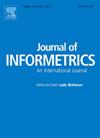Identifying high-impact interdisciplinary knowledge flows: An approach combining backward and forward citation analysis
IF 3.5
2区 管理学
Q2 COMPUTER SCIENCE, INTERDISCIPLINARY APPLICATIONS
引用次数: 0
Abstract
Identifying high-impact interdisciplinary knowledge flows can provide guidance for interdisciplinary innovation management. Previous studies insufficiently address the impact of interdisciplinary knowledge flow on the target discipline, which hinders the accurate capture of valuable interdisciplinary knowledge flow. This paper proposes an innovative method to identify high-impact interdisciplinary knowledge flows by combining backward and forward citation analysis. Backward citation analysis aims to reveal the critical interdisciplinary knowledge inflow, while forward citation analysis aims to understand the continuous impact of interdisciplinary knowledge. By integrating them, the whole process of interdisciplinary knowledge flow can be comprehensively analyzed. The discipline of Information Science & Library Science (ISLS) and Biomedical Engineering are explored as the target disciplines in the case study, and the paper data from 2015 to 2023 is collected. The results reveal that the flow path can be divided into four types. In a total of 699 interdisciplinary knowledge flows of the ISLS discipline, 105 with high-impact are identified. In a total of 325 interdisciplinary knowledge flows of the Biomedical Engineering discipline, 71 with high-impact are identified. The interdisciplinary flowing knowledge units contained in them can be clustered into eight topics and six topics respectively. The three features of these knowledge units can be summarized as high expansibility and practicability, involving innovative applications and multidisciplinary integration. The method proposed offers a way to deeply understand and accurately capture the valuable interdisciplinary knowledge flow.
识别高影响的跨学科知识流:一种结合向后和向前引文分析的方法
识别高影响力的跨学科知识流可以为跨学科创新管理提供指导。以往的研究没有充分考虑跨学科知识流动对目标学科的影响,阻碍了有价值的跨学科知识流动的准确捕获。本文提出了一种将前向引文分析与后向引文分析相结合的高影响力跨学科知识流识别方法。逆向引文分析的目的是揭示关键的跨学科知识流入,而正向引文分析的目的是了解跨学科知识的持续影响。通过整合它们,可以全面分析跨学科知识流动的整个过程。信息科学学科&;以图书馆学(ISLS)和生物医学工程作为个案研究的目标学科,收集2015 - 2023年的论文数据。结果表明,流路可分为四种类型。在ISLS学科的699个跨学科知识流中,确定了105个具有高影响的知识流。在生物医学工程学科的325个跨学科知识流中,确定了71个具有高影响的知识流。其中包含的跨学科流动知识单元可以分别聚类为8个主题和6个主题。这些知识单元的三个特点可以概括为扩展性强、实用性强,涉及创新应用和多学科融合。该方法为深入理解和准确捕获有价值的跨学科知识流提供了一条途径。
本文章由计算机程序翻译,如有差异,请以英文原文为准。
求助全文
约1分钟内获得全文
求助全文
来源期刊

Journal of Informetrics
Social Sciences-Library and Information Sciences
CiteScore
6.40
自引率
16.20%
发文量
95
期刊介绍:
Journal of Informetrics (JOI) publishes rigorous high-quality research on quantitative aspects of information science. The main focus of the journal is on topics in bibliometrics, scientometrics, webometrics, patentometrics, altmetrics and research evaluation. Contributions studying informetric problems using methods from other quantitative fields, such as mathematics, statistics, computer science, economics and econometrics, and network science, are especially encouraged. JOI publishes both theoretical and empirical work. In general, case studies, for instance a bibliometric analysis focusing on a specific research field or a specific country, are not considered suitable for publication in JOI, unless they contain innovative methodological elements.
 求助内容:
求助内容: 应助结果提醒方式:
应助结果提醒方式:


